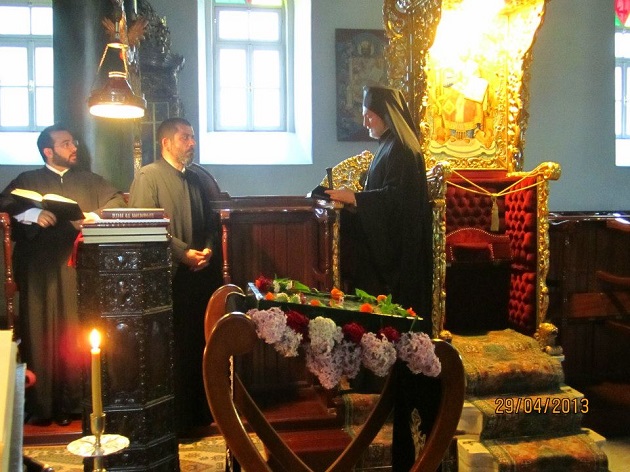H.E. Elpidoforos of Proussa: We reopen Halki!
2 May 2013A discussion with Metropolitan Elpidoforos, Metropolitan of Prousa, concerning the Monastery of the Holy Trinity in Halki.
Pemptousia: Tell us about your duties in the monastery.
His Eminence Elpidoforos: One of the priorities I set when His All-Holiness entrusted me with responsibility for the Patriarchal and Stavropegic Monastery of the Holy Trinity in Halki was to re-staff it with a brotherhood. At the time, in September 2011, there was only Father Dorotheos, whom the Lord took to his rest in April last year. Since then, Father Samouil has been ordained, first to the diaconate then the priesthood, and the Patriarch promoted him last February to the position of Archimandrite of the Most Holy Archdiocese of Constantinople. In March, I performed the tonsure of the monk Galinos, whom I shall ordain deacon at the forthcoming feast of Pentecost. Thereafter it’s the turn of the novice Dimitrios, a graduate of the Theological School of the University of Thessaloniki. So you see, God took Father Dorotheos from us, but has sent three others in his place. So we can say that through the prayers of Our Lady Who Eases Sorrow, the core of a brotherhood for the monastery has been formed.
P: What’s the programme for the services in the monastery for Great Week?
E.E.: Services day and night are, as you know, the spiritual nourishment for a monastic community and are what keeps them in contact not only with each other but, above all, with God. The dominant position in our daily services is occupied by the patronal, wonder-working icon of Our Lady Who Eases Sorrow, our protectress. During Great Week, the services are more movingly penitential and attract the faithful from Halki as well as groups of pilgrims from Greece, seeking calm and the ancient Patriarchal order.
P: What differences would they note between the Patriarchal order and that of Greece?
E.E.: Contrary to what people might expect from an institution such as the Ecumenical Patriarchate, the Patriarchal order is generally not grandiose. Naturally, it’s impressive and majestic, but the magnificence springs more from the well-regulated movements and the compunction in the attitude of the celebrants, from the plain, ancient Byzantine singing of the chanters, free from Eastern hyperbole and Westernizing cadences. In Constantinople we never wonder how any one service is celebrated. Nor is there any difference in the order of service from one parish to another, from one Metropolis to another. The order to be followed is not contingent upon the preferences or the inclination of the chief celebrant. We all know what, when and how to do something. It’s the power of the living continuum of tradition, of an order that’s never been interrupted but has been passed down from one generation to the next, like the Apostolic succession. This, if you like, is the secret of the unforgettable experience of Easter for every Greek who chooses to celebrate the Resurrection of the Lord in Constantinople. It’s also why the City will forever be a pilgrimage destination of choice for Greeks, an ecclesiastical, historical and cultural reference point which never shifts.
P.: Could you give us some idea of the services in the monastery?
E.E.: One thing that’s particularly moving in the School is the procession with the Winding-Sheet of the Precious Cross, with stops at the cemetery (where Patriarchs, School Principals and Professors lie at rest) and at the entrance gate of the School. We chant as we walk, accompanied by the mournful hooting of the owls and the calm sound of the sea-gulls, the incense mingling with the fragrance of the lilacs, myrtles and night-blooming jasmine. On the night of the Resurrection we’re a handful of people and we sing “Christ has risen” on the balcony of the School. From there we can make out in the distance proud Pringkipos and the vast Bithynian lands of the Metropolis of Chalcedon.
On Easter day, what we tried last year and it was a success so we’ll do it again this year, was that we invited the General Consuls of the Orthodox countries in Constantinople and their families to the Agape Vespers. Each one read the Gospel in his or her own language and then we had a common meal, with the traditional roast meats, the hard-boiled Easter eggs which we clashed together. Everyone brought the customs of their own country and we sang songs from the different places. It was a Pan-Orthodox feast. This year, again in co-operation with the Consulates of the Orthodox countries, we’ve chartered a special boat that will bring all the Orthodox and their families to Halki, where there’ll be a repeat of last year’s wonderful event which was greatly enjoyed by everyone who took part.
P.: What message is Halki sending to the world this year?
E.E.: We’re opening Halki. We’re opening it even before it’s opened as a Theological School by the Turkish authorities. We’re opening it as a coenobitic monastery. We’re opening it as a venue for Church events. We’re opening it as a place for meetings, conferences and symposia. We’re opening it as a pilgrimage shrine. We’re opening it as a centre for hospitality. We’re opening it as a place of study, in the Library. We’re opening it. What we want from you is your presence at our side in all our efforts.
P.: Thank you!
E.E.: Thank you, too, and have a good Easter!
The interview was given to Pemptousia’s co-operator Petros Panayiotopoulos.








